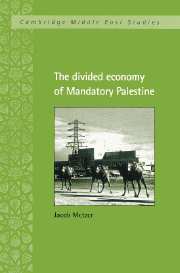Book contents
- Frontmatter
- Contents
- List of figures
- List of tables
- Preface
- Acknowledgments
- Note on numbers
- 1 Palestine's economic structure and performance: introduction and overview
- 2 The peoples of Palestine: a comparative account
- 3 Patterns and characteristics of Palestine's (Jewish) immigration
- 4 Production resources in a divided economy: land, capital, and labor
- 5 Production and trade
- 6 Public sectors in Palestine's economic life
- 7 Postscript: some observations on economic coexistence in ethno-national adversity
- Appendix
- References
- Index
- Cambridge Middle East Studies
7 - Postscript: some observations on economic coexistence in ethno-national adversity
The area of Mandatory Palestine, past and present
Published online by Cambridge University Press: 18 December 2009
- Frontmatter
- Contents
- List of figures
- List of tables
- Preface
- Acknowledgments
- Note on numbers
- 1 Palestine's economic structure and performance: introduction and overview
- 2 The peoples of Palestine: a comparative account
- 3 Patterns and characteristics of Palestine's (Jewish) immigration
- 4 Production resources in a divided economy: land, capital, and labor
- 5 Production and trade
- 6 Public sectors in Palestine's economic life
- 7 Postscript: some observations on economic coexistence in ethno-national adversity
- Appendix
- References
- Index
- Cambridge Middle East Studies
Summary
As suggested in the introductory chapter and demonstrated by the detailed accounts in the rest of the book, the economic fabric of Mandatory Palestine can best be fathomed in the context of a “dual economy” approach. The basic ingredients, broadly defined, of economic dualism were all shown to be major attributes of Palestine's ethno-nationally divided economy. To recapitulate, these are: persistent socio-economic gaps between the economy's advanced sector and its relatively traditional one; divergent developmental regimes within which each sector conducts its separate economic life; bilateral trade in production factors, goods, and services, whose composition is largely determined by inter-sectoral differences in endowments of physical and human resources and by disparities in production technology and in market structure. It has also been stressed that the effective constraints on intersectoral socio-economic convergence and market unification, necessary to sustain economic dualism, may have reflected ethnic (or other) segmentation, institutional rigidities, market imperfections (including discriminatory market behavior), and, in certain instances, deliberate policies of exclusion.
A well-known example of economic dualism that exhibits these entwined factors evolved in the (primarily) African settlement colonies. European settlers, whose economic activity was concentrated in labor-intensive plantations and crop farming, mining, and to a lesser extent manufacturing, were sharply distinguished from the indigenous nomadic herdsmen and peasants. However, in his study of the economic history of Kenya and Southern Rhodesia, Paul Mosley (1983) showed that the mark of a “settler economy” is not necessarily any specific economic structure, but rather a distinctive mechanism of “extra-market operations” and intervention by the colonial administration.
- Type
- Chapter
- Information
- The Divided Economy of Mandatory Palestine , pp. 200 - 212Publisher: Cambridge University PressPrint publication year: 1998



